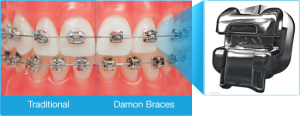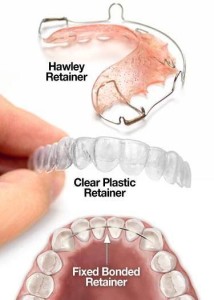Orthodontics
Orthodontics is the specialty of dentistry that involves changing the position of teeth in your mouth, using braces or other orthodontic technologies. Using either brackets & wires or clear aligners, orthodontics can reposition your teeth in a variety of ways. It can straighten rotated teeth, separate crowded or overlapped teeth & close gaps between teeth.
What is Orthodontics?
 Improving your smile with orthodontics can increase your confidence & self-esteem. But straight teeth are beneficial for more than just your appearance. When teeth are not properly aligned, they can be difficult to clean well enough to prevent tooth decay. If you can’t get floss between your teeth to clean out plaque, you risk unchecked tooth decay & gum disease.
Improving your smile with orthodontics can increase your confidence & self-esteem. But straight teeth are beneficial for more than just your appearance. When teeth are not properly aligned, they can be difficult to clean well enough to prevent tooth decay. If you can’t get floss between your teeth to clean out plaque, you risk unchecked tooth decay & gum disease.
Additionally, orthodontics can be used to treat problems with how the teeth of your upper & lower jaws line up, known as your bite. Called malocclusion by dentists, you might have an underbite, overbite or crossbite that can cause a host of issues. For example, misaligned teeth may rub against each other or collide, wearing them down unnecessarily; or a misaligned jaw may cause TMD symptoms, such as pain in the head, neck or shoulders.
When is the best time to get orthodontic treatment?
The best time to get orthodontic treatment is between the ages of 10 & 14 while the teeth are still moving into their final places. However, teeth move throughout life, so there isn’t a bad time to get treatment. In fact, adults are straightening their teeth more commonly these days due to the benefits to both appearance & functionality of straight teeth, as well as the increased options available to them.
Traditional braces, using metal brackets & wires, are still common, but cost & treatment times have gone down over the years. Some braces systems were created to be quick, with treatment as short as six months. There are even ceramic or plastic options that are less visible than the metal brackets. And, of course, clear aligners are very popular because they are not visible & can be removed.
While orthodontic technologies work moving your teeth, it’s important to keep up with regular cleaning habits & visits to your dentist. If you have traditional braces, you might be tempted to skip flossing, but because food easily gets stuck in the hardware & between moving teeth, it’s even more important to floss every day, or even after every meal. Your dentist will show you how to thoroughly clean around your braces, including how to use threader tools to get floss behind the wires.
Cleaning your teeth is much easier with clear aligners, as you simply need to remove the aligners to brush & floss your teeth like normal.
Orthodontic treatments can give you the beautiful & straight smile you desire, but they can also benefit your oral health. So while you’ll certainly have a more beautiful smile at the end of your orthodontic treatment, you’ll also have a more functional, healthier smile!
We are proud to offer a range of orthodontics options for our patients. If you are interested in orthodontics for either cosmetic or functional reasons, please start a discussion with us about your options.
Orthodontic FAQ
Dental braces are a type of orthodontic treatment used to correct teeth that are crowded, crooked, protruding, out of alignment or have irregular spacing. By moving the teeth into the ideal position, dental braces help to create a more attractive & healthier smile for both children & adults.
Before you can determine whether a braces option is right for you, it is important that you understand what is involved with treatment & what braces cost. We encourage you to call our office so that we can schedule a consultation for you with one of our orthodontists!
When teeth are crooked & crowded, keeping them clean becomes very difficult. If brushing & flossing cannot be completed properly, tooth decay, gum disease & possible tooth loss can occur. In addition, an improper bite can interfere with your ability to chew & speak properly, as well as cause abnormal wear to the enamel of your teeth. If your teeth are protruding and/or your upper & lower teeth don’t come together comfortably (called malocclusion, or a bad bite), jaw problems also may arise. Therefore, by keeping your teeth in the proper alignment & allowing better oral hygiene, dental braces do more than keep your smile looking good. They also help you keep your teeth, gums & oral cavity healthy.
iSmile Orthodontic Center strives to help patients of all ages achieve beautiful & healthy smiles. We offer a range of treatment plans to meet your needs. These plans involve early interceptive care, adolescent orthodontics, adult orthodontics, orthopedic care & surgical orthodontics. Braces can be for any age group, but there are optimal times to begin treatment. These days, it is recommended that children have an orthodontic evaluation at the age of 7 to determine if early intervention is needed. If recommended, early intervention optimizes results by taking advantage of a child’s skeletal bone growth & may require two-phase orthodontic treatment.
The first phase (“phase one”) is considered interceptive orthodontic treatment as it addresses overcrowding of teeth or bite problems at an early age. As an example of interceptive treatment, a narrow upper jaw that has crowded teeth & does not fit correctly with the lower jaw can be widened with an expansion device called a “palatal expander.” This lets the upper jaw line up better with the lower jaw & allows room for upper teeth to fit in alignment. Widening the palate can only occur during a small window of time in a growing child before the bone becomes too developed to change. During “phase one,” braces may or may not be used depending on the specific situation. After “phase one,” there is a resting period to allow most or all of the permanent teeth to come in. Around the age of 12 or 13, “phase two” treatment begins. During this phase, the alignment of all the permanent teeth is addressed using full braces.
If the window of time to use two-phase orthodontic treatment has passed, results can also be achieved with only one phase of treatment. However, if there is significant crowding of teeth, dental extractions may be required to create room for teeth to move into alignment. Dental extractions are another way to create space in the mouth for teeth movement.
Essentially, anyone who desires to have straighter teeth or improve their bite may be a good candidate for braces. A thorough evaluation with a qualified clinician is very important in determining whether one is a good candidate for braces. iSmile Orthodontic Center provides orthodontics for young children, teenagers, & adults. iSmile provides diagnoses & treatment plans for our patients as individuals to provide the most personal health care possible. In most cases iSmile is able to give our patients alternate treatment plans in addition to the most ideal plan.
iSmile Orthodontic Center offers metal brackets (braces) as well as porcelain (tooth-colored) brackets. iSmile uses modern expanders & other appliances, as well as a few different types of retainers. Metal braces are made of high-grade stainless steel. Ceramic braces are made of a translucent (clear) material. The only drawback to ceramic brackets is that they are more fragile, & the elastic ties can discolor between orthodontic visits.
iSmile Orthodontic Center is happy to explain all procedures, & the risks & benefits of orthodontic treatment. We welcome you for a consultation regarding crowding, spacing, bite problems, & significant or minor tooth movement.
Ceramic brackets are made of porcelain & are an alternative to metal brackets for patients who are either sensitive to metal or prefer a less-noticeable option. They are usually only applied to the front six teeth of the top arch due to the greatest visibility during everyday life. If a patient prefers to have complete ceramic brackets, they should inform the orthodontist during the consultation.
The Damon System delivers faster treatment, fewer appointments, greater comfort, & consistently high-quality results.
Damon’s self-ligating braces eliminate the need for elastic or metal “ties.” With Damon tie-less braces you can experience treatment without tightening.
Light, shape-memory wires move teeth faster & require fewer adjustments.
This clinically proven treatment approach aligns your teeth & enhances your facial aesthetics—usually without extractions or rapid palatal expanders.
Our orthodontists can help you decide whether Damon Braces are the right choice for you.
For more information, please visit Damon Braces

For some patients, we are able to offer Invisalign® treatment as an alternative to traditional metal braces. Invisalign® treatment involves a series of removable, clear overlay templates called aligners. The aligners are generated based on a computer simulation to gradually move the teeth. This type of treatment is popular because it is a more attractive alternative to traditional braces: clear aligners are virtually invisible compared to braces with wires & brackets. In addition, Invisalign® aligners are removable, making it more convenient to eat & brush.
Your Invisalign® treatment will consist of a series of aligners that you switch out about every two weeks. Each aligner is individually manufactured with exact calculations to gradually shift your teeth into place. And since your Invisalign® system is custom-made for your teeth & your teeth only, with a plan devised by you & your dentist or orthodontist, you know you’ll end up with a smile that truly fits.
Here are some steps you will need to take to get you to a brand new smile:
An initial consultation with your dentist or orthodontist: During this visit, you’ll discuss the issues you have with your teeth & what kind of results you would like to see. Once your doctor decides your situation is suitable for Invisalign® treatment, a treatment plan will be mapped out with your goals in mind. Then, impressions & pictures of your teeth will be taken for digitization purposes.
The impressions of your teeth will be digitized in order for your doctor to work with a computerized 3-D image of your teeth. Then, your doctor will plan your tooth movements throughout your entire treatment timeline. You’ll be able to see a virtual representation of your teeth before, during & after completion of the Invisalign® process so you can see what your smile should look like when you’re done with treatment.
From your doctor’s precise treatment plan, customized aligners are created with advanced technology for you to wear at each stage of your treatment. While the number of aligners varies for each individual situation, a full set of treatment typically includes 10–30 aligners per arch.
You should wear your aligners at all times, with the exception of eating & drinking, in order to complete your treatment in the timeline determined by you & your doctor. You’ll go in for occasional checkups to monitor your progress & to receive your next set of aligners. During the entire treatment process, you’ll be able to watch your teeth gradually moving into place. Your smile will, little by little, move into something you’d like to show off. The people around you will be sure to notice your new-found confidence.
The Invisalign® system is available to adult patients with certain orthodontic bite problems. Ask us if you are a candidate for the Invisalign® system.
For more information, please visit www.invisalign.com
Invisalign® trays are clear & removable, making them much more difficult to notice. However, Invisalign® is only possible in milder cases of dental realignment. Ask the orthodontist if you qualify for Invisalign® treatment.
Invisalign® usually takes 12 to 16 months depending on the complexity of the condition. Braces usually take about two years. A more accurate length can be determined after a consultation when the doctor has an opportunity to diagnose the situation.
Invisalign® checkups occur once every six weeks & last about ten minutes. Braces checkups happen once a month & last 20–30 minutes.
After tightening braces or receiving a new set of aligners, the teeth will feel soreness that disappears after one or two days. The soreness is mild & similar to what is experienced after strenuous exercise.
All patients require a cavity clearance from a general dentist before bonding. Cavities & cleanings should be addressed before treatment begins. Extractions may be necessary, but are not included in the price. The orthodontist will let you know if any extractions are recommended.
Invisalign® comes with all the aligners, records, appointments & x-rays. Braces come with bonding, records, check-ups, x-rays & consultations. Related treatments are not included, & negligent care of your orthodontic appliances may result in replacement fees. A retainer is mandatory at the end of treatment & is not included.
Insurance coverage varies from plan to plan & there may be an age limit (usually 26 years old). Insurance companies usually cover orthodontics at 50% up until the plan’s lifetime maximum, which is a separate value from the yearly maximum. The only way to be certain about a plan is to speak directly with the insurance company. However, insurance estimates are not guaranteed until the payment is actually received. The patient is responsible for all payment not covered by insurance.
Once treatment has begun, we are not able to refund the full amount, but a partial refund may be given based on the reason, as well as how far treatment has progressed.
The biggest factor is to avoid hard & sticky foods that may pull out the wire or knock brackets loose. During sports, a mouthguard is recommended. Above all, it is critical to maintain oral hygiene throughout the entire process.
Completed orthodontic treatment does not guarantee perfectly straight teeth for the rest of your life. Teeth have memory & often try to move back to their original positions. Retainers are required to keep your teeth in their new positions. Regular retainer wear is necessary for your lifetime as your body is continually undergoing growth & maturation. Minor irregularities, particularly in the lower front teeth may occur. In summary, you need your retainers to keep your teeth as straight as possible. But even with good retainer wear, your teeth may move slightly. Your orthodontist will explain to you the guidelines for wearing your retainer & maintaining your smile.
Types of retainers:
- Essix (clear)
- Hawley (wire)
- Fixed bonded (hidden)





